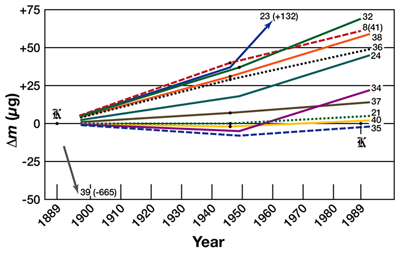Kilogram: The Present
Artifacts and Uncertainty
Many units of measure have been defined in terms of artifacts. For example, until 1960 the international definition of the meter was an artifact based on a platinum-iridium prototype rod made in 1889. The volt was once defined in terms of the output of a specific kind of wet-cell battery.

The gram itself was originally an "intrinsic standard," based on the inherent properties of a particular substance, namely the mass of a cubic centimeter of water at 4 degrees Celsius. But modern measurement science has moved away from using physical objects or other substances as standards. Before May 20, 2019, the kilogram was the lone remaining unit defined in terms of an artifact.
There was widespread agreement that the situation had to change. Aside from the considerable practical difficulties involved in calibrating individual kilogram prototypes and standards from numerous national metrology institutes against the International Prototype Kilogram (actually, against one of its working copies), there were inherent problems with the stability in the mass of kilogram artifacts.
Although the IPK was made from a corrosion-resistant alloy of 90 percent platinum and 10 percent iridium — as were its six official copies, eight working standards and two additional copies for special uses — airborne contamination can adhere to the metal surface. That is why there was a rigorous set of procedures for steam-cleaning and washing all kilogram artifacts prior to recalibrating them.
Nonetheless, the masses of these objects were subject to change over time. By definition, of course, the IPK mass could not actually change: Because it was the official kilogram, its mass was always exactly 1 kg, even if it actually gained or lost mass! Therefore change was expressed by comparing the masses of the IPK’s official “sister” copies as well as various countries’ national prototypes to the mass of the IPK on the rare occasions in which it was brought out of storage. These "periodic verifications" occurred in 1899–1911, 1939–1953, and 1988–1992. In addition, a special calibration, involving only BIPM's own mass standards, was conducted in 2014.

The trend during the past century had been for most of BIPM's official copies to gain mass relative to the IPK, although by somewhat different amounts, averaging around 50 micrograms (millionths of a gram) over 100 years. But an alternative explanation is that the IPK was losing mass relative to its copies. Even more likely, it was a combination of both.
Replacing the Artifact
Stability of the kilogram is a critical issue because its value is used to determine many other units. In particular, it directly affects the newton (the SI unit of force), which is defined as the force required to accelerate a kilogram mass one meter per second per second. The newton, in turn, is used to define the pascal (the unit of pressure) and the joule (the unit of energy or work). The joule is part of the definition of the watt and the volt, and so forth.
The world metrology community has long recognized the limitations of an artifact kilogram and on October 21, 2011, the General Conference on Weights and Measures, the diplomatic body that has the authority under the Meter Convention to enact such a sweeping change, passed a resolution declaring that the kilogram and three other units "will be redefined in terms of invariants of nature." For the kilogram, that invariant is the Planck constant (symbolized by the letter h) — a quantity more familiar to the exotic territory of quantum mechanics than to the everyday world of weights and measures.
To meet this goal, scientists around the world faced a deadline of July 1, 2017, to submit their best measurements of several important fundamental constants of nature. Many papers containing new measurements of the constants were published in the days and weeks leading to this momentous date. Data from the international scientific community were used to produce an updated value of Planck’s constant for the revised SI.
With this data, an international task force known as the Committee on Data for Science and Technology (CODATA) Task Group on Fundamental Constants (TGFC) arrived at a value of h of 6.626070150 × 10-34 kg⋅m2/s. This value was the last piece in the scientific puzzle to redefine the kilogram in terms of fundamental constants of nature.
But what in the universe does h have to do with the kilogram?

